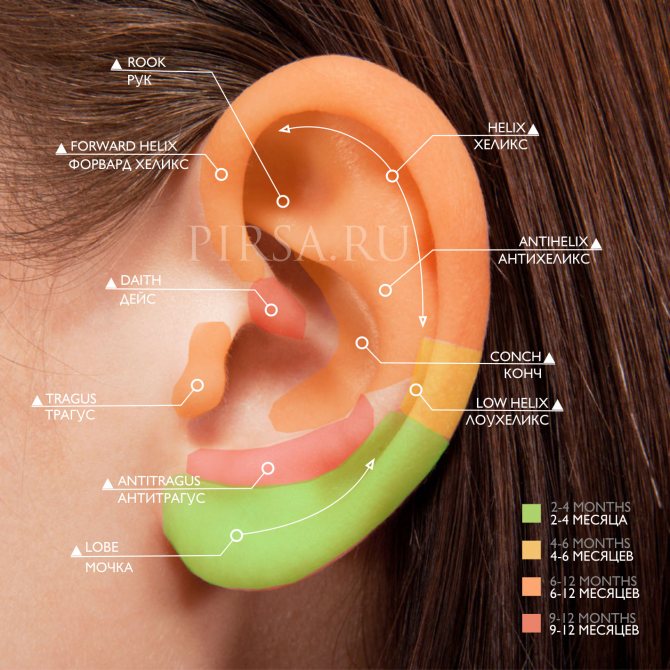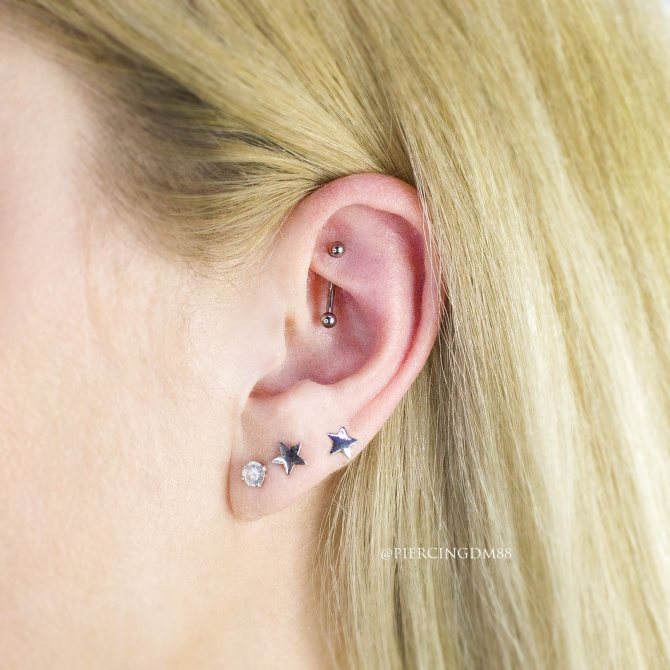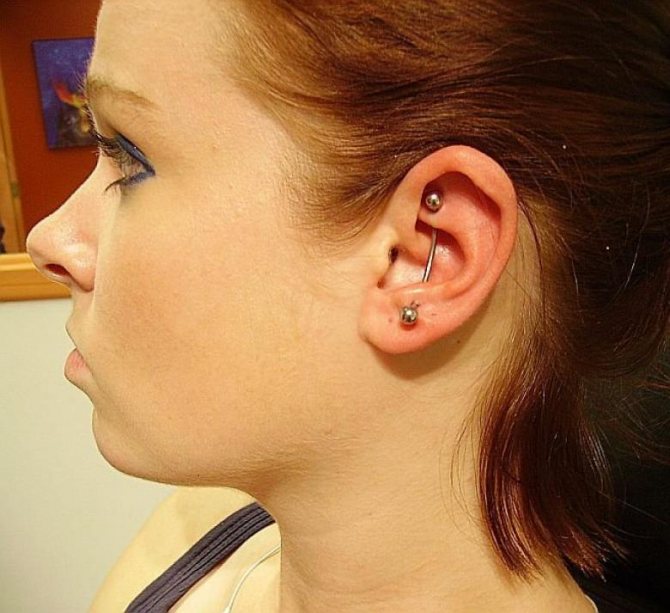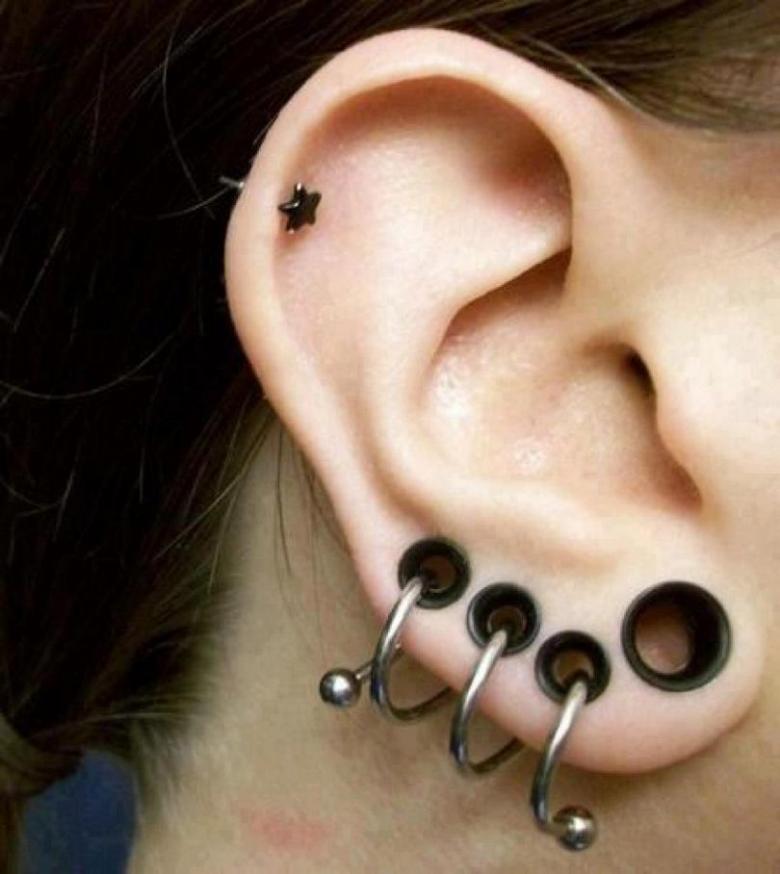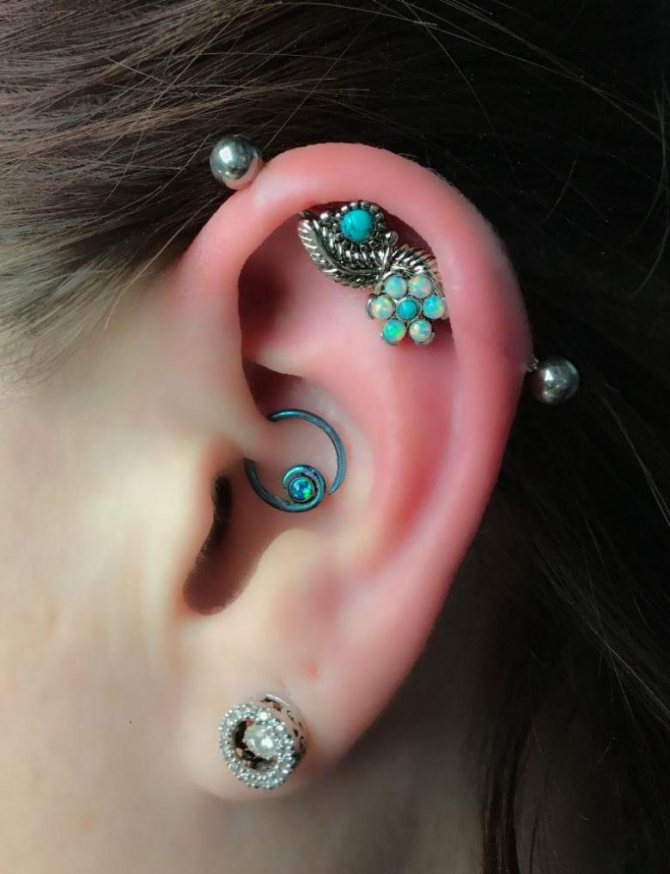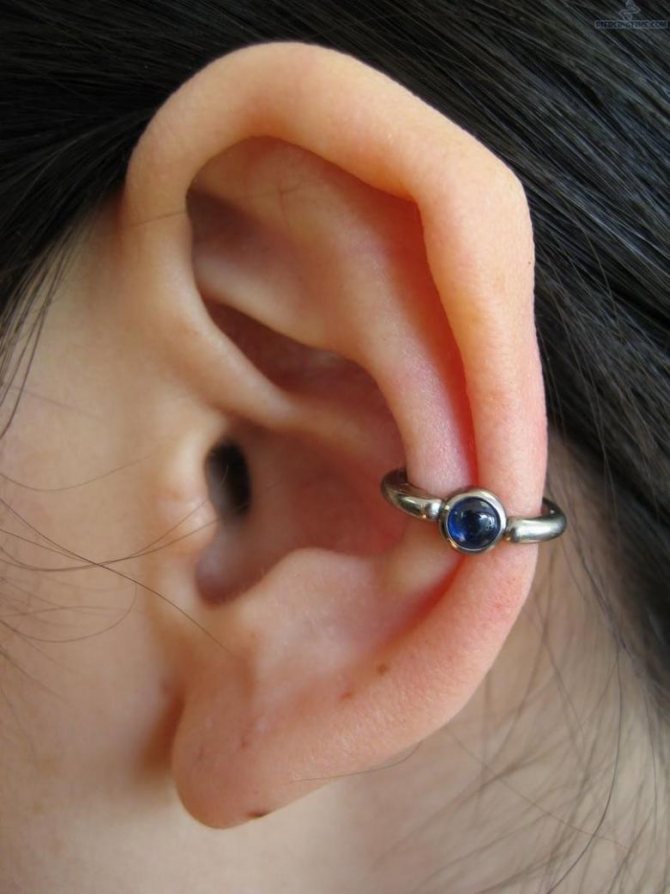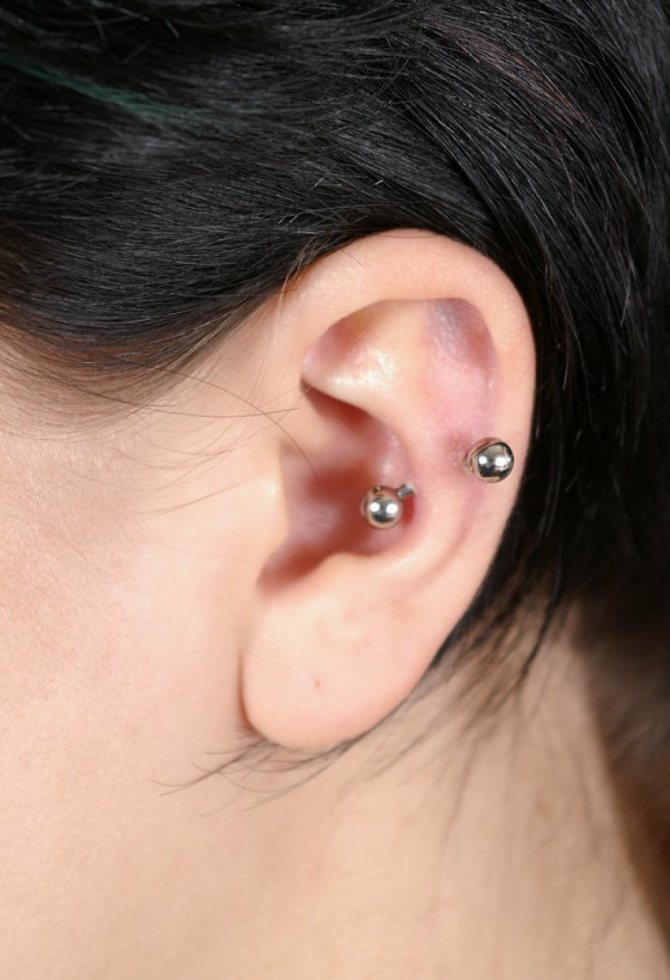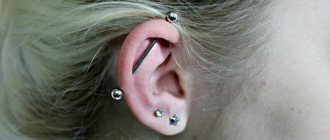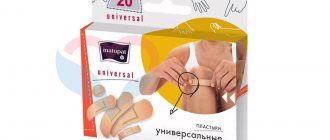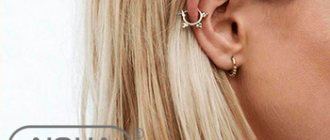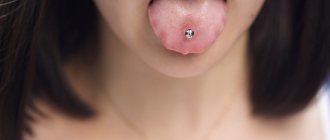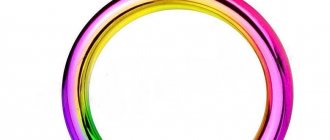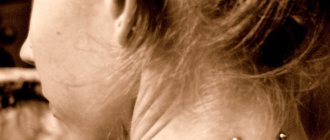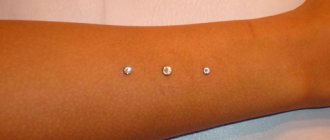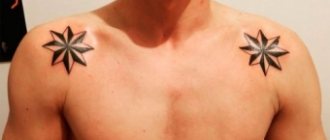Plan
- Types of ear cartilage piercings
- What kind of earring to choose?
- Stages of the procedure.
- What to do before piercing?
- Contraindications
- How does the process take place?
- Piercing care after the procedure
- What tools are used?
- How many days of healing?
- Possible complications after piercing
- What problems can occur and why?
- Advice
- assortment
- What's in fashion?
The history of ear cartilage piercing goes back to the depths of centuries: in the past, every element of the image had meaning, now the stylish earrings-ring - a beautiful, spectacular element of a complete image. To get the result, the piercing is done with a special tool.
It is interesting that ear piercing is one of the oldest forms of body modification. It was done long before our era, which is confirmed by archaeological research. In the twentieth century, there was a real "boom" in piercing - concerning the piercing of the lobe, it was done by girlfriends at home to each other. Gradually, this procedure is turning into a separate service of a medical specialist.
Cartilage piercing differs significantly from earlobe piercing - and the procedure, and the tools used, and the care and healing process. This type of piercing is painful, sometimes anesthesia is required.
Types of ear cartilage piercings
- Helix - a type of piercing, when they pierce the upper part of the shell on the curl, partially capturing the cartilage. The peculiarity of the procedure is that it is quite painless, as there are no nerve endings there.
You can not pick up jewelry of great thickness - if the earlobe is stretched (for example, under the tunnels), the cartilage is not.
- Forward Helix is also a cartilage piercing, but in the opposite place from the previous type. Usually several piercings are made here for miniature jewelry.
It should be taken into account that the healing, in this case, the process is long - about 4 months.
- Industrial piercing is a type of cartilage piercing, which implies 2 mandatory holes on the upper cartilage, between which is inserted an earring rod. The most popular option: one hole in front of the shell, near the head, the second - at exactly the opposite point.
Initially, it is not recommended to insert an earring of steel, a few months wear jewelry made of bioplastic - while the healing process takes place.
- Deis piercing is supposed to be a piercing in one of the curls of the inner cartilage, performed from top to bottom. Half rings, rings, rods of a certain type can be placed. Sometimes several piercings are made. This type is universally suitable for both sexes.
After the piercing, the earring is inserted immediately, it should not be too thick so as not to cause discomfort. The healing process, depending on various factors, can last up to 8 months.
- Ruuk piercing is a piercing in the cartilage of the ear opposite the goatee on the protrusion. It is more difficult if the ear shell is naturally small, but this is not a limitation if this is the type of piercing you want. It is a difficulty only for the master. Also carefully and carefully need to select the jewelry - not everything will fit. Take into account your anatomical features and consult a professional.
- Orbital piercing is a kind of double piercing. The peculiarity is that the ini connect the ring. The number of piercings can be different, but at once the procedure is not performed - it is performed in stages, so as not to cause discomfort and complications. It takes up to 1 year to heal.
The specialist does not just pierce, but before that he carefully calculates the distance between the holes, taking into account possible changes in the cartilage itself.
- Tragus piercing - the piercing of the goatee, the most elegant option, is considered feminine. The piercing is supposed to be made in the front part of the shell. Suitable for it are miniature rings, carnations.
Immediately after the procedure, you need to be careful - do not sleep on the side of the piercing, it is undesirable to use an earpiece.
Types of earrings
With the emergence of new types of piercings, the list of jewelry that can be worn in the ears, too, has been expanded. We suggest you explore the main types of earrings for ear piercing.
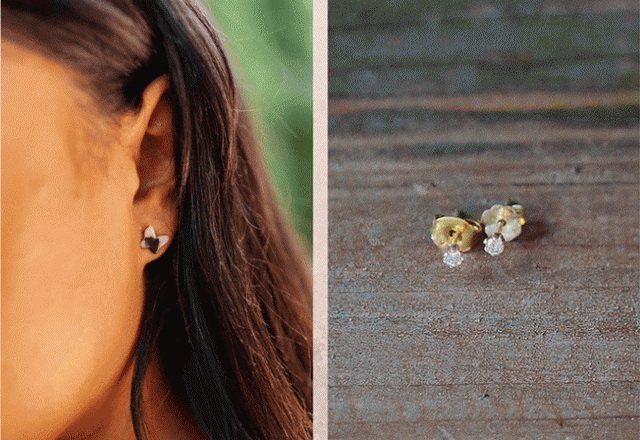
Earrings - These are the earrings that we are all familiar with.
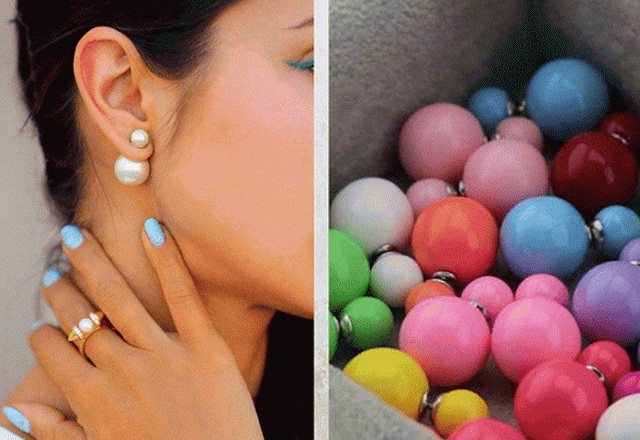

Diorki - resemble a carnation, but they have decorative elements on both sides. Often, a larger decorative element is placed behind the lobe.


Jackets - are carnations with a complement. The addition is a curved part with a decorative element that is visible under the lobe. The curved part is located behind the lobe.
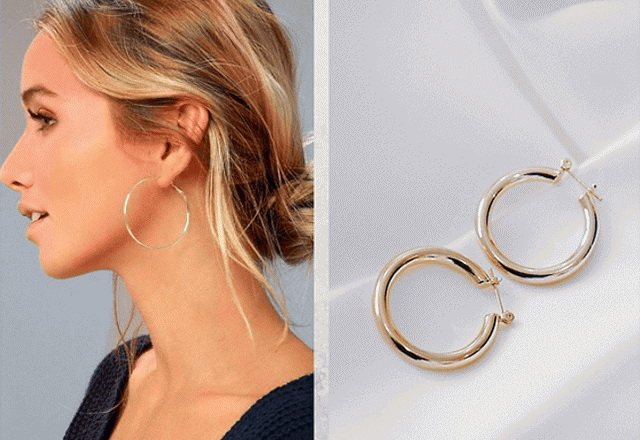

Rings - is not just jewelry in the form of rings, it is a certain type of clasp. The thin edge goes into the thicker and hollow edge, resulting in a solid ring with a barely noticeable junction.


Earrings with pendants - Most often, they are jewelry with an English clasp, complemented by large vertical elements.


Cuffs - These are big pieces of complicated jewelry, which are fixed in the upper part of the earflap and do not require piercing. It's all about the right weight distribution of the accessory.
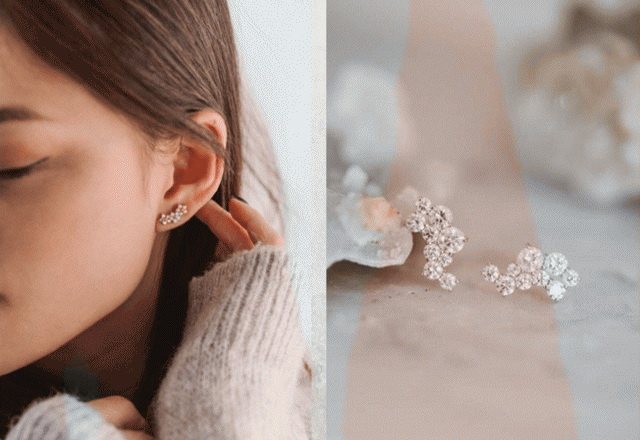

Clymbers - are oblong earrings, which are inserted into the hole in the lobe. The decorative element is positioned from the lobe upwards along the bottom of the curl. The principle of fixing such jewelry resembles the principle of invisible hairpins.
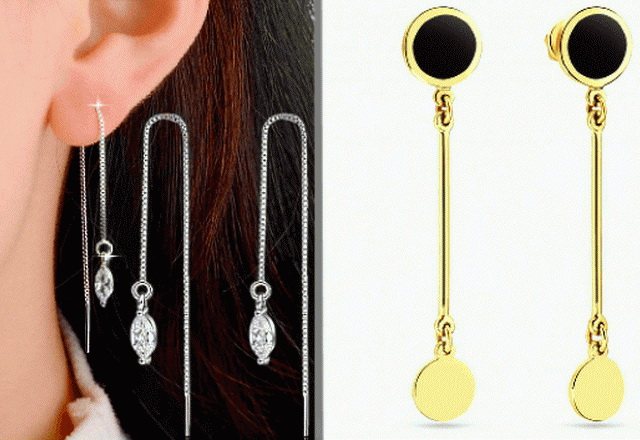

Prongs - The earrings are made of thin chains with smooth oblong pins. Such earrings do not have clasps and are held in the ear thanks to their though small, but weight. Some earrings look like studs, but with a chain dangling behind the lobe, while others dangle both in front and behind the lobe.
A true piercing master will tell you that earrings are jewelry exclusively for the earlobe. Accessories put into holes in other parts of the ear are called piercing jewelry, but not earrings.
Here are the main types of jewelry used for ear piercings:
- A barbell - similar to a diorca, but with small decorations and an elongated rod.
- Banana - this is, roughly speaking, a barbell with an arc-shaped rod.
- A circular is a strongly curved rod, that is, in the shape of a horseshoe.
- Twister - the same rod, but with an elongated and curved rod, the product resembles a spiral.
- Labret - reminiscent of a nail, but instead of the clasp-bolt, the labret has a smooth disc.
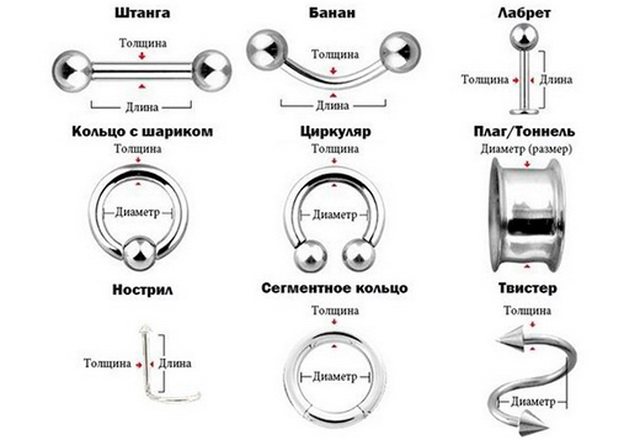

The master will prompt you which jewelry to choose depending on the type of piercing and your anatomical features, because the structure of the ear lobe of each person individually.
Even earlobes come in different sizes and shapes, let alone cartilage.
Now you can decorate your ears not only with fine earrings, but also with non-standard types of piercings.
If you're not afraid of painful piercing and long healing time - experiment to the max!
0 Comments
What kind of earring to choose?
Initially, before piercing, decide on the thickness of the earring, because the hole in the cartilage is not stretched, as in the case of the lobe.
- One of the most popular options is the barbell or barella. The optimal solution for industrial-type piercing. Visually, it is a tube with locks, it does not bend. The decor is varied - stones, studs and other decorations.
- The ring is a standard type of earring for both cartilage and lobe. The circle is not closed, in place of the missing part is a balloon insert or other decoration.
- Labret-decorated stick, similar to a pousseta. The straight wand is bounded by discs on each edge.
- Circular-a horseshoe that is terminated with balls on both edges.
- Banana - an earring of a characteristic shape, with a twist - a ball or cone - on both ends.
Stages of the piercing procedure
- If there are no contraindications for the procedure, the specialist makes preparations:The specialist examines the features of the ear; disinfection of the ear with alcohol; the place of the piercing is marked with a special marker. Some puncture sites are much more painful than others. An anesthetic may be used.
- Fixation with the instrument is by means of a clamp.
- A catheter needle is manually pierced through the cartilage - the needle is removed, leaving the catheter.
- Then a previously disinfected jewel is inserted into the catheter, and it is gradually pushed out by the earring.
- Finally, the catheter is removed from the stem and the balloon is screwed onto the earring.
Varieties
The main method in the classic version is the piercing of the earlobe. It is used by both women and men. Even toddlers are ideal for this method, and for boys there is a piercing on one ear. Often a double or triple piercing is performed, but no more because of the interference of the cartilage.


The modern trend is with the help of a gun. The technique has proven itself positively because of the speed and absence of pain. The products are beautiful to look at:
- Nails.
- Hoops.
- Labrets.
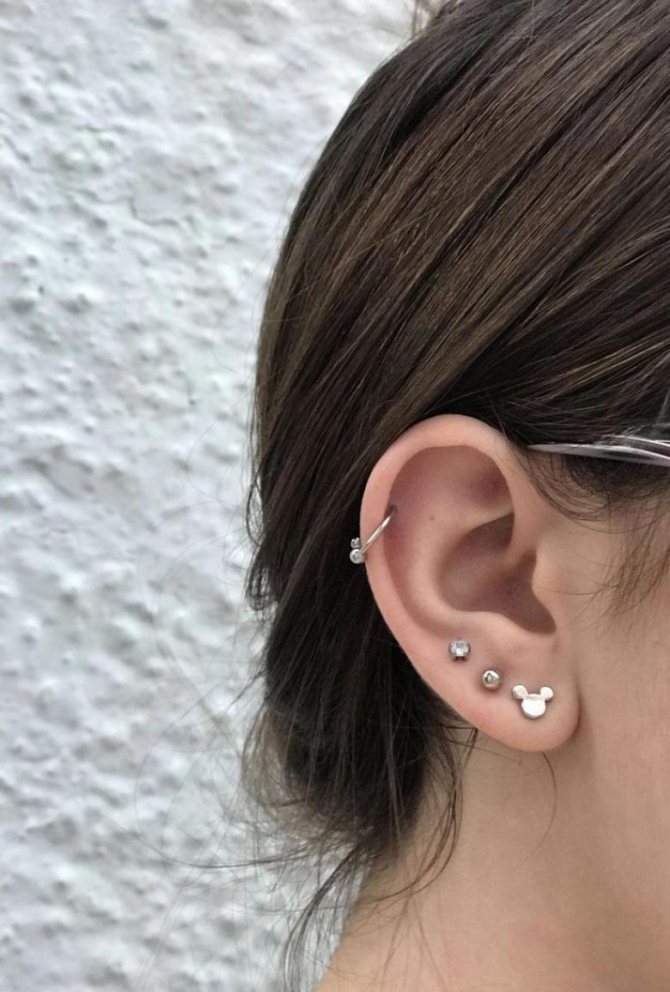

The method has also gained wide popularity among the stronger sex. The choice of men's earrings is truly enormous.


Preparing for the piercing procedure
The puncture site is preliminarily examined by a specialist to assess the location of vessels, anatomical features of the ear.
The main point is that piercing the cartilage of the ear is painful, more difficult than piercing the lobe. Before piercing, start with the lobe.
- First, the entire ear is disinfected - it is treated with 95% alcohol.
- The jewelry itself, which will be inserted immediately after the piercing, is disinfected: this is done in an autoclave (dry fire), which allows you to kill 99.9% of germs. The disinfection process takes 15-30 minutes.
- The puncture point is dotted with a special antiseptic marker and anesthesia is administered.
Since the procedure is quite painful, local anesthesia is used: external, injected or both together. A special cream or spray is applied to the skin as an anesthetic, then an injection is injected. Sometimes only external anesthesia is enough - it all depends on the location of the puncture and the pain threshold of the client.
Contraindications
There are a number of features that make it impossible to perform ear cartilage piercing - primarily to protect against difficult and dangerous consequences.
First of all, the piercing cannot be done by yourself, anywhere, it is dangerous to entrust the procedure to anyone - the process can have irreparable consequences if something is done incorrectly. You should turn to professionals!
Before the procedure, the master draws attention to the anatomical, physiological features of the client's ear. Extremely important - sterile conditions of the operation.
In some cases, a professional, a master with a license, will refuse to perform the procedure. Grounds for refusal:
- Any blood disorder;
- Pregnancy;
- Client is under the age of majority;
- Craniocerebral trauma;
- Client has diabetes mellitus;
- Rheumatism, arthritis;
- The client has been treated for illness (influenza, acute respiratory viral infections).
When it is forbidden to pierce the cartilage
Alas, but in this case there are also its own little things, compliance with which is simply necessary. To be more precise, there are bans on ear cartilage piercing. And very often there are people who have absolutely no idea about this, who go to get their cartilage pierced and get a lot of health problems. And sometimes they know about the problems, but they completely ignore them. If you want to be okay with your ear and your health in general, you should not get your ear cartilage pierced in certain cases:
Cranial injuries that have not yet healed are an important prohibition against performing a piercing.
If there are inflammatory diseases of the ear, you should also refrain from earring.
Allergy reactions that can wake up at any time can also be a barrier.
Ear cartilage piercing is also prohibited in a variety of disorders directly related to the psyche.
Damaged skin in the area of the shell of the ear, also prohibits ear piercing.
If a person has a fever or is in a serious condition associated with fever, it is strictly forbidden to pierce with a gun or catheter, the method does not matter.
If suddenly a woman who is pregnant, decided to pierce the cartilage in the ear, she should first visit the doctor and consult with him on this issue. If a child wants to pierce the ear, in no case in the early years should not use a medical needle. At first, only the gun is allowed, and then, when the child becomes a teenager or is over 18 years old, it is allowed to pierce with a catheter.


How does the process work?
The cartilage is specially illuminated with a lamp to determine the anatomical features, the location of the vessels. Then preparatory work is done - decontamination of the ear with alcohol, placing a point on the puncture point. A needle-catheter of the required thickness is used to make the hole. Immediately an earring is inserted into the puncture.
There is no need to fear for vision, hearing or other bodily functions. There is a stereotype that piercing carries the danger of damaging nerve endings. Large nerve branches cannot be damaged, so there is no need to fear for your health. Especially if you trust a professional.
Care of the piercing after the procedure
Healing after a cartilage piercing takes longer than in the case of an earlobe. To the process went without any special problems and complications, it is recommended to follow these recommendations:
- You should not touch the place of the piercing - this is important, because it is quite easy to get an infection.
- Healing occurs over a period of 4 weeks - those earrings that are inserted after the piercing immediately, do not need to be removed during this time.
- For a certain period of time, baths and saunas are prohibited, for the same reason as in the first point. For the first three days after the procedure, you should be extremely careful with water procedures. A categorical ban on swimming in natural bodies of water.
- Moving, twisting the earring, installed after the piercing, is impossible - the more you irritate the puncture zone, the more thickened the fibrous tissue becomes.
- Ban on hot baths and showers - water with a high temperature can provoke bleeding.
- Take care not to catch the puncture with your hair or clothing.
- It is not recommended to sleep on the side, in which the piercing was made - in the sleep a person can twist, and you will not notice how you traumatize the piercing area.
- The main point - you can't use alcohol as an antiseptic, because you can get tissue burns.
For quick healing and care, experts recommend special products, taking into account the type of piercing.
For the first 4 weeks, you need to treat the piercing with antiseptic regularly - only then can and should you rotate the earring. This is to ensure that the product is evenly distributed along the canal, the entry and exit points of the earring - everything must be thoroughly disinfected.
If you do sports, after taking a shower, you need to additionally treat the hole with antiseptic.
If the puncture site, with proper care, is red, swollen, causes painful sensations, you need to contact the specialist who performed the piercing as soon as possible.
How long will it take for the cartilage to heal?
Actually, after a person has experienced for himself whether it hurts to pierce the cartilage in the ear, he is interested in the healing and care of it. If a regular lobe heals quickly enough, it takes about a month to restore the hole in the cartilage. Earrings on the cartilage should not be removed during this time, but it is allowed and even useful to constantly move it and twist it. It is necessary to do this in order to develop the ear piercing and not to let the hole overgrow.
With how long the pierced cartilage will heal, we have already decided. Now it is necessary to talk about its care and care for it. To prevent the formation of infection on the cartilage, it is necessarily necessary to use special antiseptics. For example, it is Levomecol - a special ointment that helps recovery after a puncture. In addition, the use of hydrogen peroxide or Baneocin - a special powder that will also have an extremely positive effect - is allowed. The puncture must be watched carefully, treated with reverence and treated twice a day with peroxide, ointment or powder, and at the same time the earring must be twisted inside the hole, because the product must penetrate directly into the canal itself. As for alcohol, its use is strictly prohibited, it can only have a negative effect on the pierced ear in the cartilage area. In the first three days, it is strictly forbidden to visit open water bodies and swimming pools, as well as baths. After you have taken a shower or a bath in your house, you should additionally treat such a delicate and needy cartilage on the ear.
If suddenly you notice that the ear is noticeably red, there are certain secretions coming out of the pierced place, you see inflammation or something similar, which cannot be attributed to normal healing, it is urgent to seek help from your doctor. He will tell you exactly what is wrong with the cartilage of the ear and how to get rid of such problems.
What tools are used?
In terms of the set of tools, the piercing of the cartilage of the ear is different from the piercing of the lobe. The lobe is pierced with a special gun, a needle. The hole can be stretched, depending on the diameter of the ornament - you don't have to be careful about the diameter.
With cartilage, there are a bit more problems:
- Since it does not stretch, you need to initially choose a special needle number for a specific size.
- For piercing, a catheter needle of a certain number is used - it indicates the size of the future hole.
- They also use a final clamp, a clamp and a special clamp for the ring.
The main tasks of a specialist who performs piercings is to avoid two problems:
- Crushing the cartilage of the ear.
- Getting injured by improper actions.
To avoid problems and injury, piercings are done by hand with a needle, as a gun can crush the cartilage.
Possible complications
During the piercing process, problems are possible: crushing the cartilage of the ear and injuries, getting infection. What are the risks?
- Using a gun can crush the cartilage, so the piercing is done with a sterile catheter needle.
- If crushing occurs, cartilage may die off and take a long time to heal.
- Even if healing occurs, there may be scars, large holes that do not heal. To avoid necrosis, you should not only consult a professional, but also treat the puncture site regularly.
- Another risk is associated with allergic reactions - this is not a frequent problem, but it is worth noting that an adverse reaction of the body may occur to some metals. It is recommended to use medical or jewelry style, titanium as the first earring.
What problems can arise and why?
First of all, the most dangerous factor is dirt, germs, mechanical damage. Contact with any dirty objects, microcracks can cause blood infection, purulent processes, bleeding.
If you have been ill with viral diseases (especially shortly before the piercing), otitis, diseases of the upper respiratory tract, it can negatively affect the regeneration process, the healing process will take longer.
Permanent mechanical influences, scars - a consequence of improper care. If you notice a small deviation from the norm, immediately contact a specialist to understand the cause of the problem. In some cases, not only normal care, but also therapy with more serious methods is required.
The most common problem is inflammatory processes. Causes:
- The earring is constantly removed, forgetting that this should not be done for 4 weeks;
- Bathing in the river, lake - this is a sure step to get dirt, microorganisms into the unhealed puncture;
- Not regularly treating the puncture site;
- The procedure was performed incorrectly, by a non-professional.
Scarring, purulent inflammation, bumps, abscesses, seals are signs not only of poor hygiene, but also of low immunity and infectious diseases. In rare cases, rejection on the contrary is a sign of a high level of immunity.
If any abnormal sign appears, you should immediately contact a specialist. You may need medication for a speedy recovery.
What an earring in the ear means
The tradition of decorating your body dates back to ancient times.
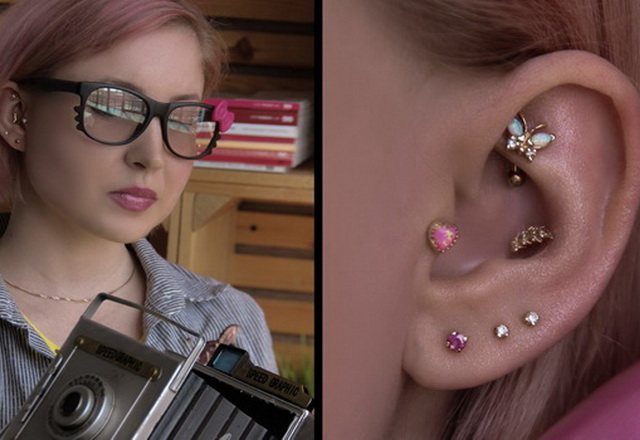

Public opinion about what ear piercing means has changed at different historical eras, the meaning has varied at all times.
Earrings could be a sign that in front of you a girl of easy virtue, a slave or, conversely, an aristocrat.
There are many legends and beliefs and misconceptions associated with earrings.
It is believed that centuries ago sailors wore expensive earrings so that they could be buried with all honors if they died away from home.
There is an opinion that earlobe piercing improves vision, but doctors do not support this myth.
The most burning question is which ear to pierce? Girls often pierce both lobe at once, but in the future you can make additional piercings, wear kafes, etc., besides, mono earrings are in fashion.
The talks that an earring in this or that ear is a sign of non-traditional orientation, nothing is confirmed, so you can safely pierce any ear. Choose the side that is more photogenic, because everyone has slightly asymmetrical facial features.
Today, earrings are nothing more than a stylish accessory that can complement the image or attract attention.
Recommendations
- There is no need to start with ear piercings from the cartilage, try experimenting with the lobe first - the procedure is less painful and heals quickly (up to 1.5 months).
- Want multiple piercings? You don't need to do several operations at once - it's a painful process.
- Be sure to carefully care for the puncture itself, especially the first year.
- Don't forget that it takes longer to heal the cartilage, the procedure itself is painful.
- Tell the specialist right away if you are allergic to certain metals. It is advisable to find out if you have any allergies before the procedure.
- Observe hygiene - treat the orifice 2-4 times a day, be sure to do so after showering, sports activities.
- Carefully wear headphones, it is better to use wireless ones.
- Be sure to wash your hands thoroughly and treat them with antiseptic before treating the root canal and the edges of the hole. For the treatment of the canal, saline solution is suitable.
Assortment
Freak Boutique offers quality and stylish earrings for ear cartilage piercings - in steel, titanium, brass, with or without stones.
- Surgical steel ring with a minimalist cross - without unnecessary decorations, stones. The material is safe for human, does not cause irritation and is not subject to corrosion. Ring thickness - 1.6 mm.
Surgical or jewelry steel is popular in the field of jewelry making, as it is strong enough, hypoallergenic, relatively inexpensive, hygienic. The surface has no pores, so harmful microbes can be only on the surface, and it is easy to disinfect. The necessary properties of the alloy give its components - nickel, molybdenum, chromium.
- The 8 mm diameter ring is made of black surgical steel with a flat insert. It is easy to fix by means of an expanding mechanism.
- Ring with expanding mechanism, made of surgical steel. Thin - thickness 1,2 mm, diameter - 8 mm. The main feature is the presence of white opal inlay. The stone shimmers with blue and pink highlights.
A similar variant is the ring with amethyst. On the miniature insert is a stone of light purple hue. The diameter is slightly larger than the previous variant - 1 cm.
- A 1.2 mm thick titanium ring for ear cartilage. The highlight is a rounded insert with an opal in a rich, bright blue color.
Titanium is considered the metal of the future, due to its properties, it is more often used for jewelry because it is: relatively inexpensive, durable, looks good, has low weight, hypoallergenic.
- A ring made of surgical steel with a ball-shaped insert. The anodized metal gets an unusual look - the surface is multicolored, iridescent. The diameter of the product is 1.1 cm.
A similar variant - without the ball-insert, the usual smooth titanium ring.
- The ring-clicker is made of high quality 925 sterling silver, unclenched. Recommended for the nose, but also suitable for the ear.
The labret is made of titanium, a strong, hypoallergenic metal. Suitable for punctures in different points of the cartilage of the ear. The main highlight is the opal stone decoration (turquoise, pink, lilac-white, blue-green). The labret is equipped with an inner thread for fixation.
Jeweled or surgical steel labrettes without stones are a great option as your first piece of jewelry. Several size options are available.
Circulars are often used for both septum and ears. This horseshoe model is made of surgical steel, in black. The ends have spiked cones.
The industrial barbells are one of the most striking pieces of jewelry, especially for punk, cyberpunk styles. Available in a wide range of rod inserts that play the role of decor: with symbols, with inserts of stones, with a chain. There are also removable decorations on the bar.


What do piercing earrings look like?
Of course, for those who are far from the world of piercing, the differences in earrings are almost imperceptible, and consist only in the shape of the products. However, in fact, the models presented as jewelry today can vary greatly in cost and aesthetic appeal, as well as in wearing comfort. So, let's consider the main options.
Barbel and barbell.
This is a straight wand with holes at the ends, on which screws, balls, pebbles can be fixed. The base is made of bioplastic, medical alloys or precious metals. They are used not only for ear piercing, but also in piercing places on the body: the bridge of nose, navel, tongue, nipples, sometimes intimate areas. Standard sizes range from 1.6 mm to 50 mm, depending on the destination.


Labrettes
The most widespread type of jewelry with a flat disc at one end and a bead or stone on the other. Along with conventional bars are used for piercing the earlobe or cartilage, cheeks and lips. Standard model sizes range from 1 mm to 1, 6 mm. Thicker products are considered uncomfortable, as there is an increased risk of trauma to the pierced area.
Labret
Curls
A bar of various sizes is used as the basis for the curls. The curl itself in this case acts as a decoration, and can have several variants. The most common are gemstones, but it can also be regular balls, hearts and other shapes. By shape, the "tip" of the rod is also divided into bezel, cabochon, prong, cluster and flat-gem. It is essentially a rolled stone, a flat uncut stone, a crystal in a setting, several crystals in a composition and flat-bottomed rhinestones, respectively. The items are detachable, allowing you to change the earrings at will.
Banana
Slightly curved bars, resembling a banana. They are appropriate for lip piercings, nose piercings, microdermal piercings and flat piercings. Some people decorate their tongue, navel, eyebrows and intimate body parts with them. Nailheads are selected by size, carving, and type of stone. With standard barbells, picking a product to suit your taste is not a problem.


Circular
Similar to the rod, twisted almost in a circle. Stylish jewelry for septum, earlobes, Daith piercing and other options. Most often decorate the ears, eyebrows, lips, nose, navel and nipples. Sizes are chosen depending on the type of piercings, but most commonly have standard values from 1.2 mm, up to 16 mm.


Circular
Clamping ring.
A type of jewelry differs from its "brethren" in the type of clamp. The device implies the presence of two grooves, in which the ring is snapped. The decoration can be supplemented with a removable element. It can be either a ball or a crystal. The clasp ring is popular for piercing the septum, lobe and Daith. It is most often used for ear, lip, nose and eyebrow piercings.
In addition to the basic varieties of jewelry, there are also many variations, different details among themselves. In particular among the most famous can be attributed segment ring, similar to the clamp version, twister, which resembles a circular, retainer - an improved version for the septum, clicker, suffrais bar, and other types of jewelry. You can find the perfect solution by contacting a professional who you are willing to trust to perform the piercing. Along with care instructions, the master will tell you about the properties and characteristics of different types of earrings.



